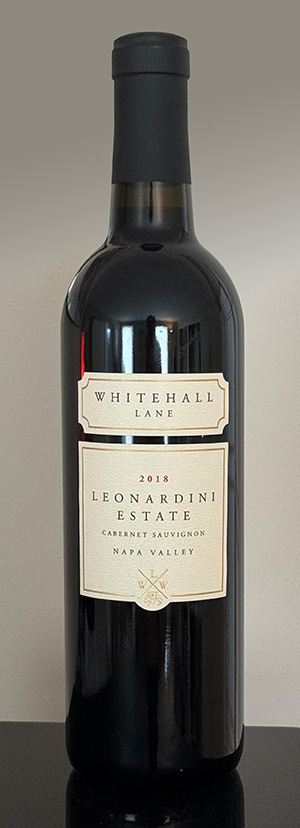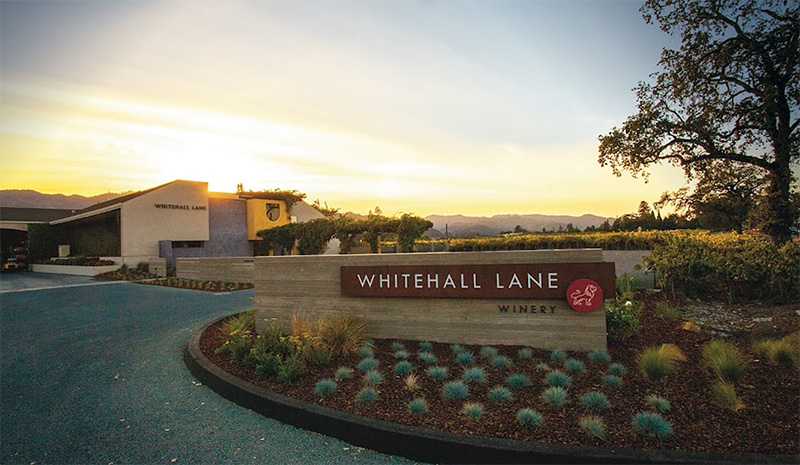
Whitehall Lane Leonardini Estate Cabernet Sauvignon 2018
Under the stewardship of the Leonardini Family, Whitehall Lane continues to produce world-class wines, garnering accolades and awards for its dedication to excellence.
Napa Valley settlers were drawn to the gravelly loam soils and ideal climate over 150 years ago, planting high-quality grapevines at what is now the Whitehall Lane Winery site. The estate vineyards, located in the Rutherford Appellation, stand testament to the enduring allure of the region’s quality soils.
Control of the property has been transferred numerous times. Guiseppe and Rosalie Baranzini owned it in the 1940s and ’50s. Davis Bynum held the land in the 1970s, but failed to secure a winery permit (although not long after he would become the first vintner to produce single-vineyard Russian River Valley Pinot Noir), and sold to Howard Allen. He also was unsuccessful at establishing a winery, and sold to Art and Bunnie Finklestein and Art’s business partner and brother, plastic surgeon Alan Steen, and his wife Charlene in 1979. It was they who finally successfully founded Whitehall Lane on the 25-acre vineyard, setting the stage for the winery’s future. (Allen went on to be a long-time grower for Williams Selyem, starting in 1980.)
Their first vintage was in 1981. Seven years later, the Finklesteins sold the winery to Japanese-based real estate investor Hideaki Ando. (The Finklesteins remain a well-known winemaking family in Napa, currently operating Judds Hill Winery.
In 1993, the Leonardini Family acquired the estate, bringing with them a commitment to enhancing winemaking and vineyard practices. With updates to barrel-aging programs and a scientific approach to vineyards, the Leonardinis have propelled Whitehall Lane to new heights.
Tom Leonardini, whose last name means ‘little lion’ in Italian, found his way to the wine industry through a serendipitous journey. His family’s roots in California trace back to the Donner Party, and Leonardini’s venture into the wine world started with a wine shop in San Francisco, opening the tiny Napa Valley Wine Exchange in 1985, initially focusing on Napa wines but later including wines from other parts of California. At the Exchange he met a number of winemakers and others in the wine business. Leonardini had ambitions to start his own winery, and through some of these contacts he learned of a promising property that was for sale but not yet listed publicly. He drove up to Napa, met with Hideaki Ando, and purchased the Whitehall Lane Winery in 1993. He hired Gary Galleron on as the founding winemaker.

Over the years, the Leonardini family has expanded the vineyard holdings, cultivating approximately 200 acres across eight unique vineyard sites in St. Helena, Rutherford, Oak Knoll, and even venturing into neighboring Sonoma Valley. The commitment to family involvement is evident, with Leonardini’s children playing key roles in the winery’s operations. Daughter Katie oversees the overall winery operations, her brother Tom is responsible for domestic and international distribution, and another son, Tony, is a winemaker.
Whitehall Lane’s dedication to producing exceptional wines has not gone unnoticed. It has been recognized by Wine Spectator Magazine and awarded Winery of the Year by Quarterly Review of Wines and Wine and Spirits Magazine.
The winery’s offerings include a diverse range of premium wines, with Cabernet Sauvignon and Merlot leading the way. Showcasing a commitment to innovation in winemaking, Whitehall Lane was among Napa’s first wineries to use screw cap enclosures for some of their wines. They were also the first to use Vinolok (aka VinoSeal) glass stoppers, in 2003. This has largely been abandoned, however, with only a handful of whites under screw cap and the glass stoppers gone entirely.
In the face of challenges, such as the 2005 arson wine warehouse fire in Vallejo, Whitehall Lane persevered and adapted. That fire was one of the reasons why they expanded their own barrel facilities, now allowing them to store all of their barrels on site. In 2018, 750 solar panels were installed on the roof of the winery, and the winery is now certified Napa Green (a certification program by Napa County Department of Public Works and the California Green Business Program overseeing water conservation and reduced energy and waste within Napa County wineries).
Total production has fluctuated over the years, from 5,000 cases in their first vintage to now around 45,000 cases annually. They have excellent domestic distribution and some international presence including in parts of Canada, Japan, and the UK.
Whitehall Lane Leonardini Estate Cabernet Sauvignon 2018
The fruit for this selection came from the Leonardini, Fawn Park, and Millennium MM estate vineyards in the Rutherford, St. Helena, and Oak Knoll District appellations. After hand harvesting in the early morning hours, the Cabernet Sauvignon and Petit Verdot were destemmed and sent to tank for a whole-berry fermentation. The grapes were cold-soaked in tank at 45 ̊F for four to seven days. After inoculation, the grape juice, skins, and seeds fermented at 82 ̊F, which allowed for a hot extraction on the skins. After fermentation and pressing, the wine was sent to 65% new French oak and 35% neutral French oak barrels, and aged for 26 months. The final blend for the Leonardini Estate is 96% Cabernet Sauvignon and 4% Petit Verdot. This wine was unfined and unfiltered.
This 2018 Leonardini Estate Cabernet Sauvignon is a very dark red, clear but nearly opaque. The nose features leather and cocoa. On the palate, it delivers dark chocolate and tart cherries and a bit of slate. The underlying tannins are well structured, and it all ends in a medium finish. ABV is 14.8%.
Back to blog posts: winervana.com/blog/
